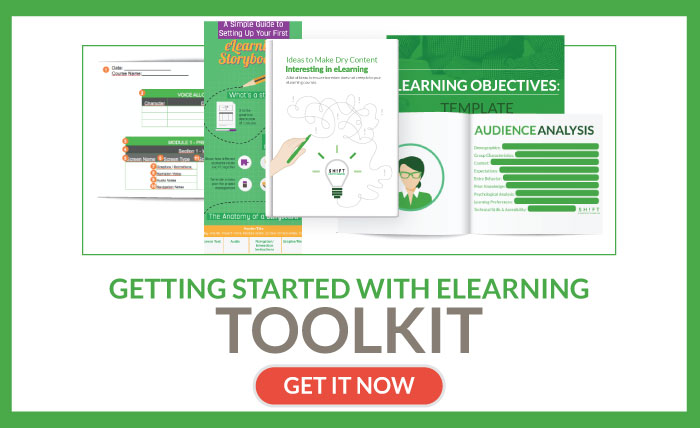Micro Learning is a hot trend in eLearning design. We all know this. To get up to speed on the theory behind microlearning check out the resources at the end of the blog post.
In the rest of this post, we are focusing specifically on calls to action. That is, how do you actually apply the principles of Micro-Learning to your eLearning design? Our hope is that by the end of this post you will be prepared to start thinking micro and create effective learning experiences.
Take into consideration these actionable tips:
1) Design Micro, Personalized and Flexible Learning Paths
Learning paths maximize their potential when combined with other helpful strategies like micro learning and personalization.
People have limited time to engage with content. Also, everyone starts at a different level with each concept. Thinking modularly when creating eLearning courses is a great way to offer students flexible and differentiated learning paths they can consume anytime they need.
Giving learners the opportunity to choose their path and pick the content they want to consume at the point of need, maximizes the short time that the learner has to devote to learning.
Also read: The Rapid Rise of Learning Pathways
2) Go beyond Mobile-Friendliness - Think Mobile First!
It is smart for eLearning designers to focus on mobile-first courses. We are no longer living in a world where this type of content delivery is only use by some. We are living in a world where everyone uses mobile in their day-to-day life.
Considering most people will navigate eLearning courses on mobile, Micro-Learning becomes even more relevant. Having your workers take long-form content on their mobile devices not only decreases productivity but also increases the possibilities of subject matter comprehension and application as learners will get easily distracted.
Also read: Start Thinking of MicroLearning Moments Now
3) Pick the Big Idea
With Micro Learning, you have about 5-10 minutes to make an impact on the learner in a way that is transferrable and can lead to demonstrable changes in behavior. It may sound simple, but this is a BIG task! Whereas in traditional eLearning design, you might have picked 3-4 big ideas to cover in a module, in Micro Learning you need to stick to ONE idea. Use this idea to guide all of the decisions you make with regards to learners and what is important for them to experience in the course.
4) Use Visuals to Create More Impact
It takes time to read a text, and most of us are not very good at skimming for important parts. Visuals can be a very effective way to direct the learner’s focus immediately on the most important parts of the content.
Think back to the big idea and decide what the most meaningful parts are and design them visually.
It is important to note that the visual you choose to use needs to have some intrinsic value. Placing one that does not add anything to the learning experience simply wastes the learner’s valuable short time (especially on mobile).
5) Use Micro to Invite People to Longer Learning
Even though Micro-Learning is the latest trend in online learning, it does not mean that Macro Learning is no longer needed. Sometimes, Micro-Learning should be used in preparation for an annual conference or workshop or as a pre-test before face-to-face training. This type of design helps to prepare everyone for the conference/training session so that they can maximize their time there.
Similarly, Microlearning can be used after a conference or workshop to follow up on what was discussed in the professional development event. In this case, it should be used as a reflection or as a connection to the workplace to encourage a transformation of actions based on the concepts learned.
Also read: When Designing Microlearning, Keep Macro in Mind
6) Combine the Power of Micro Content + Spaced Repetition
Combining Microlearning with spaced repetition means delivering bite-sized pieces of information in different moments, asking learners to recall and apply information in different ways.
By offering spaced practice via mobile devices with key data or facts, it allows students to refresh their knowledge and easily develop a learning habit that will boost their motivation to continue learning.
Also read: How to Design eLearning Programs with Spacing In Mind
7) Mass Customization
Think about the last time you were in a public place watching the paths people took and where they went. Did anyone follow the same exact path? Now expand this to the course of the week. It can be virtually assured that no one follows the same path for a week. The same concept can be applied to micro learning design. You will likely have dozens of mini modules or pieces of learning. Learners will be able to pick and choose from many of these, and they need to make a coherent learning experience.
This can seem impossible. However, applying artificial intelligence for instance can help to customize the learning experience. Imagine creating a system in which a recently completed module pulls up other modules similar to that one they just completed, just like a Netflix experience.
8) Micro Credentials
One of the difficulties with Microlearning is developing a tracking system for learners. When larger courses are complete learners often get a certificate or other record. Along with more granular content, there needs to be a certificate to match that level of learning.
Many of you have heard of digital credentials matching one learning experience. However, think about one credential for ten micro learning moments. The credential gets filled in as the learner completes those ten experiences. These could be grouped by levels of complexity, subject matter, or any other organizational structure you can think of.
You are now ready to start designing micro learning with some best practices in mind. Use the resources below to get up to speed on the theory of micro learning. With this knowledge in mind, you will emerge as a leading micro learning designer.
Numbers Don’t Lie: Why MicroLearning is Better for Your Learners (and You too)
Think Small: 8 Commandments of MicroLearning
Struggling to Train New Hires Effectively? Try Micro Learning
5 Tips To Make Microlearning Successful



